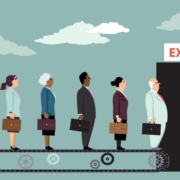Mapping the Employee Journey: From Onboarding to Resignation
In today’s modern workplace, it’s vital to understand the journey your employees go on.
Not only is this key in terms of helping your employees to grow and develop but it’s imperative in terms of overall business success.
This journey is not just about processes and policies; it’s about the individual’s emotions, expectations, and engagement levels.
With that being said, below, we’ll map out the typical employee journey in full.
What is the ‘employee journey’
The employee journey can be best visualized as a roadmap, detailing every key touchpoint, experience, and milestone a worker encounters from the moment they join a company until their eventual exit.
The importance of understanding the employee journey
It’s vital for both employers and employees to understand the employee journey. There are numerous reasons why:
For employers:
- Optimize processes – If you understand every phase of the journey, you can then refine processes effectively, from recruitment to retirement.
- Increase employee retention – A well-mapped journey helps identify areas of employee discontent early on. Addressing these issues proactively can reduce turnover and related costs.
- Enhance your brand as an employer – A positive, clearly defined employee journey can become a strong selling point for prospective talent, establishing your company as an attractive place to work.
- Create a feedback loop – You’ll have a structured framework for gathering feedback, which means management is empowered to make timely, data-driven decisions.
- Growth and development – With clarity on how your employees progress through your business, you can invest effectively in targeted training and upskilling.
For employees:
- Clear career pathway – An outlined journey will give your employees a sense of direction, helping them visualize their growth and progression in your company.
- Empowerment – Knowing the journey fosters a sense of ownership. Employees are better positioned to voice concerns, seek opportunities, and actively engage in their roles.
- Personal growth – As employees understand the journey, they can identify areas of personal development, be it skills, relationships, or leadership capabilities.
- Transparency and trust – A documented journey promotes openness, enabling employees to know what to expect. They’ll trust in your commitment to their well-being.
Consider creating an employee handbook
To further support these goals, having a comprehensive employee handbook is essential. It serves as a foundation for clear policies and processes, enhancing both the employer brand and the employee experience. You can use this employee handbook template to get started.
The power of preboarding
Preboarding is the phase that bridges the gap between a successful job offer and an employee’s first day.
Think of it as the prelude to onboarding, setting the stage for a new hire’s journey in your organization.
Importantly, preboarding is not just an administrative process.
It’s an opportunity to create the first real impression of the company culture, the teams, and the role itself.
Especially for top talents, who are brimming with enthusiasm, this phase offers a window to channel their excitement and to ensure they feel valued and engaged even before their official start date.
Activities typically involved in preboarding
✔️ Paperwork
✔️ Setting up tools and systems
✔️ Initial introductions
✔️ Preliminary training
The impact of a smooth preboarding on the overall onboarding experience
By developing an excellent pre boarding process, you’ll set the tone for your employee’s entire journey with your business.
This matters for a number of reasons:
- Boost confidence – Your employee will feel prepared and ready to take on their new role.
- Create excitement – A glimpse into your company’s culture, values, and teams can amplify enthusiasm, ensuring new hires are eager to contribute from day dot.
- Promote early engagement – New hires want to get started right away. Preboarding leverages this enthusiasm. It makes sure that new workers feel part of the team, even before they officially start.
- Reduce first-day jitters – Being a new person is always daunting! However, when a new hire is already familiar with tools, systems, and a few faces, it can make the first day more productive and less scary.
The significance of onboarding
“You never get a second chance to make a first impression.” – How many times have you heard this quote from Will Rogers?
The onboarding process is basically your new hire’s introduction to your company.
This initial phase has a big impact on how an employee perceives your business. Whether positive or negative, these perceptions often last.
Laying the foundation for a productive and engaged employee
Onboarding is not just about introductions and training. It’s about laying the foundation for an employee’s future with your company:
- Relationship building – By introducing new hires to their teams you can create camaraderie, ensuring a collaborative work environment.
- Feedback channels – If you establish clear communication channels from the beginning, employees are able to voice concerns, ask questions, and seek guidance. This promotes an environment of continuous learning and improvement.
- Cultural immersion – Onboarding allows new employees to dive deep into your company’s culture. Activities, team lunches, or group projects can give insights into team dynamics, company traditions, and the unwritten norms of your business.
Early days: Settling In
In the initial days, new employees are often raring to go but may also feel like a fish out of water. They have the skills and enthusiasm but may lack the specific knowledge and context to perform at their peak.
This is where training programs and mentorship come into play.
Customized training programs, which are tailored to the employee’s role, will enhance skills, help them get familiar with tools, and understanding processes.
Pairing a newcomer with a seasoned employee is also beneficial. Mentors can guide new hires through the intricacies of their roles and responsibilities.
Plus, by giving someone a go-to person for doubts, feedback, or even general company queries, you make the settling in process a lot easier.
Maintaining engagement and motivation
Now that your employee is part of the team, it’s all about keeping those engagement and motivation levels high. We’ve identified three critical ways of doing so:
- Recognition and rewards – Employees thrive in an environment where their efforts are noticed and appreciated. Recognition and rewards send a clear message that your employees’ efforts matter. They also boost morale and encourage healthy competition.
- Work-life balance and employee well-being – Rested and well-balanced employees are often more productive, innovative, and driven. Plus, they take fewer sick days and are more consistent in their attendance.
- The role of leadership and communication – Leaders need to articulate a clear vision, ensuring every team member understands and feels connected to the larger company goals.
Explore tools like Great People Inside Instruments to enhance your employee journey.
Continuous learning and skill development
Regular performance reviews and constructive feedback loops are critical. They help to align your goals with your employees’ goals, fostering a culture of mutual growth.
Simultaneously, if you provide opportunities for employees to move up the career ladder and take on more tasks, there are two clear benefits:
- You show commitment to your employees’ futures
- You’ll have a more skilled workforce, which can propel your business forward
Recognizing signs of disengagement
It’s often said that employees don’t leave companies; they leave managers or a toxic work culture.
An individual’s disengagement doesn’t just affect them but has ripple effects across the team and business. It can:
- Drain morale
- Reduce collaboration
- Increase workload for others
- Disrupt ongoing projects
- Tarnish your work culture
Disengagement is like a silent alarm, signaling deeper issues in the fabric of your business, whether it’s leadership, work culture, or employee relations.
Recognizing and addressing it is not just about retaining an individual but safeguarding the collective spirit, productivity, and future success of the team.
Addressing concerns and providing support
It’s essential to establish open communication channels so you can truly understand and address employee concerns. Examples include surveys, one-on-ones, and robust feedback systems.
This will foster a transparent environment where employees feel valued and heard.
Receiving a letter of resignation
When employees want to leave, they’ll hand in a letter of resignation. You can see these letter of resignation examples to get an idea of what to expect.
While each individual’s journey is unique, there are common factors that often lead to resignation:
- A perceived lack of advancement opportunities or role stagnation
- Issues like unsupportive managers, toxic team dynamics, or an incongruent company culture
- Insufficient remuneration or benefits compared to industry standards
- Overburdening workloads or inflexible schedule
- Sometimes, individuals seek fresh challenges, a change in career direction, or personal growth outside the current business
If someone wants to leave, it’s important to conduct an exit interview.
Direct feedback can reveal systemic problems or specific areas of concern that may have been overlooked.
Plus, learning why employees leave can provide guidance on how to better attract and retain talent.
Post-resignation: Offboarding and alumni relations
Even after an employee departs, maintaining a positive relationship can have benefits. Former employees can be ambassadors for the brand, vouching for the company’s values and work culture.
Such relationships ensure departures are amicable and open the possibility of rehiring should circumstances align.
To turn offboarding into future opportunities, you should offer one-on-one exit interviews, uncover possible areas for improvement in the business, reinforce confidentiality, and sign them up for your alumni program. In fact, a lot of people do the latter early on.
Conclusion: The cyclical nature of the employee journey
The employee journey isn’t linear; it’s cyclical. From the first introductions to offboarding, and sometimes back to a reunion, the journey is evolving all of the time. Therefore, understanding and perfecting the employee journey is something that requires your continual attention. It’s not a one-time thing.
Article By Kerry Leigh Harrison
Kerry Leigh Harrison has over 11+ years of experience as a content writer. She graduated from university with a First Class Hons Degree in Multimedia Journalism. In her spare time, she enjoys attending sports and music events.











